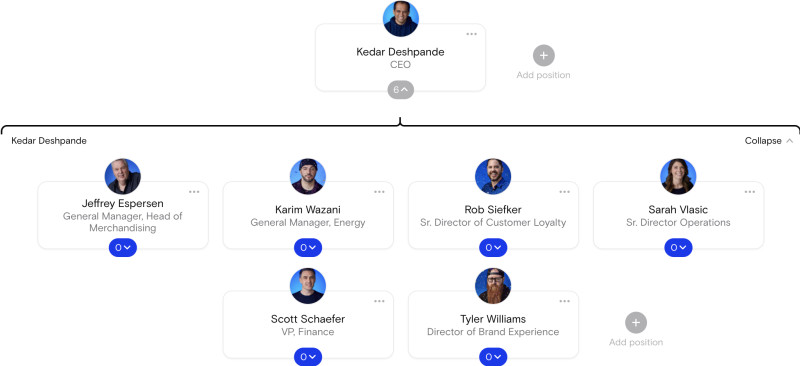- Iterate
- Organizational Structure
- 5 Main Types of Company Reporting Structures
5 Main Types of Company Reporting Structures
Table of contents
There are five major corporate reporting structures, based on different types of organizational structures. This is all of the information you need to decide which is best for your company.

Organizational structures determine who reports directly to the chief executive officer (CEO). There are five major corporate reporting structures, based on different types of organizational structures.
Each has its pros and cons, and will be suited to some types of businesses and departments, but not others. This is all of the information you should need to decide what is best for your organization.
Hierarchical Structures
A traditional hierarchical structure looks like a pyramid, with the CEO at the top, followed by the C-level executives, who report directly to the CEO.
This organizational structure can either be functional or divisional.
In a functional organizational structure, employees are grouped based on their specific skills and functions within the company.
A divisional organizational structure, on the other hand, can either be market-based, product-based, or geography-based. In a market-based structure, divisions can pertain to industry or customer type. In a geography-based structure, divisions can refer to regions, territories, or districts.
Either type of structure is ideal for complex organizations serving several markets, carrying multiple product lines, or operating in several regions.
Fig. 1: VMware
Fig. 2: Abbott
Figure 1 shows the organizational structure of VMware, a functional organizational structure. Figure 2 is Abbott’s divisional organizational structure divided into different markets.
The chain of command in a hierarchical structure is top-down. This means that the CEO makes decisions based on reports or information submitted to him by C-level executives.
Leaders in the C-suite have technical and functional expertise in their area. Each of them should have a strong grasp of the fundamentals of business. When they make their reports to the CEO, they also offer strategies and insights on how to approach certain situations. They also often create business models or risk management strategies to include in their reports.
This type of reporting has benefits as well as downsides. One downside is the slow speed of information gathering and how quickly the information can be relayed to the CEO. As the executives rely on people down the structure for all their information, it could inhibit the CEO's ability to make quick decisions in a given situation.
Functional and divisional structures can also create silos. These silos may hamper interdepartmental communication. The report the CEO gets from different functional or divisional heads may potentially conflict with one another if communication between departments is not good.
Get in front of millions of visitors and job seekers.
- Showcase your company culture to a vast community of professionals
- Host your team on a free org chart to keep employees aligned
- Post jobs on our free job platform for high growth startups
Flat Structures
Flatter or flat organizational reporting structures still maintain a certain hierarchy, but in this case power-distribution is less concentrated on just a few individuals.
Reporting also remains structured with high-level managers and executives interacting and reporting directly with the CEO. A key difference with flatter structures is the inclusion of middle managers or supervisors. It’s not only C-level executives who can give their input. Companies like Cisco and Whirlpool follow the flatter type of organizational structure.
In a flat organization, there are usually no titles or seniority. There are no formal executives. The company’s founder is usually the CEO in flat organizations.
In flat organizations, the CEO interacts with everyone. Communication lines are open. Every employee is allowed to discuss ideas directly with the CEO. This structure is not without its pitfalls, however, as it can lead to the forming of cliques that work exclusively on their own projects. It could also lead to competitiveness in vying for approval from the CEO. It could prohibit collaboration and communication between employees.
Flatarchy
A flatarchy is a hybrid type of organizational structure. It blends functional and flat structures to allow for a more distributed type of decision-making. This model can be both powerful and disruptive as evidenced by Google, LinkedIn, and 3M who are among the many corporations that use this type of structure.
Fig. 3: Google Cloud
In a flatarchy environment, there is an existing structure or hierarchy. However, the company allows employees to make suggestions or run with their new ideas. Ideas that get approval become new teams that follow a flat structure. These new teams have autonomy, resources, and no bureaucracy.
In terms of reporting, flat teams can directly report to the CEO as they are essentially separate units. The CEO gets first-hand updates and information on the project being developed by the team. These teams can even eventually develop a more formal structure.
Holocracy
A holocracy has decentralized management and decision-making. It has self-managing teams that are responsible and accountable for their actions and decisions.
Fig. 4: Zappos
This is not a common structure as it can require radical changes. Zappos is one of the handful of companies that has shifted to this type of structure. They have adopted this structure to allow for a more distributed decision-making process. People can also work in departments where their talents are most useful.
Reporting to the CEO in a holocracy does not follow a structure. Instead, information is open, accessible, and discussed during meetings. Small to medium-sized organizations can benefit from this type of company reporting structure.
Want to design your own company's structure according to any of these models? The best way to do it is with our free org chart platform.
Get in front of millions of visitors and job seekers.
- Showcase your company culture to a vast community of professionals
- Host your team on a free org chart to keep employees aligned
- Post jobs on our free job platform for high growth startups





